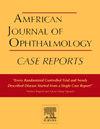Bilateral corneal pannus in Crohn's disease and assumed adalimumab-associated ocular surface disease
Q3 Medicine
引用次数: 0
Abstract
Purpose
Anti-tumor necrosis factor (TNF)-alpha inhibitors are commonly used in the treatment of inflammatory bowel disease (IBD). Despite a beneficial risk-profile, dermatologic and ocular complications may particularly develop at higher doses. Here, we report a case of bilateral corneal pannus in a patient with Crohn's disease, which occurred following a prolonged adalimumab overdose.
Observations
A 19-year-old male with Crohn's disease presented with progressive bilateral blurred vision, conjunctival injection, and light sensitivity. Clinical examination, including best-corrected visual acuity (BCVA), slit-lamp biomicroscopy, and funduscopy, revealed severe bilateral corneal pannus with vascularization extending superior to the limbus. The patient had been mistakenly administering adalimumab (40 mg) weekly instead of biweekly for over two years. Given the suspected medication-induced ocular surface disease, adalimumab was discontinued, and the α4β7 integrin antagonist vedolizumab was initiated. Adjunctive topical and systemic therapy was also implemented. At the 2-month follow-up, corneal pannus regressed, visual acuity improved, and ocular symptoms significantly decreased. Further improvement was observed at the 4-month follow-up.
Conclusions and importance
Bilateral corneal pannus can be a rare ocular complication of long-term TNF-alpha inhibitor therapy. Particularly in young IBD patients, dermatologic and ocular complications should be considered. In severe cases, modification of the immunosuppressive agent along with targeted therapy should be implemented to prevent vision loss.
克罗恩病和假定的阿达木单抗相关眼表疾病的双侧角膜泛膜
目的抗肿瘤坏死因子(TNF)- α抑制剂常用于治疗炎症性肠病(IBD)。尽管有有益的风险,但在高剂量时可能特别发生皮肤和眼部并发症。在这里,我们报告一例克罗恩病患者的双侧角膜pannus,发生在长期阿达木单抗过量服用后。患者为19岁男性克罗恩病患者,表现为进行性双侧视力模糊、结膜注射、光敏感。临床检查,包括最佳矫正视力(BCVA),裂隙灯生物显微镜和眼底镜检查,显示严重的双侧角膜膜,血管化延伸到角膜缘上方。患者错误地每周服用阿达木单抗(40mg),而不是每两周服用一次。考虑到疑似药物性眼表疾病,停用阿达木单抗,并启动α4β7整合素拮抗剂维多珠单抗。辅助局部和全身治疗也被实施。在2个月的随访中,角膜覆盖消退,视力改善,眼部症状明显减轻。在4个月的随访中观察到进一步的改善。结论及重要性:长期tnf - α抑制剂治疗后,双侧角膜泛膜是一种罕见的眼部并发症。特别是年轻IBD患者,应考虑皮肤和眼部并发症。在严重的情况下,应实施免疫抑制剂的修饰和靶向治疗,以防止视力丧失。
本文章由计算机程序翻译,如有差异,请以英文原文为准。
求助全文
约1分钟内获得全文
求助全文
来源期刊

American Journal of Ophthalmology Case Reports
Medicine-Ophthalmology
CiteScore
2.40
自引率
0.00%
发文量
513
审稿时长
16 weeks
期刊介绍:
The American Journal of Ophthalmology Case Reports is a peer-reviewed, scientific publication that welcomes the submission of original, previously unpublished case report manuscripts directed to ophthalmologists and visual science specialists. The cases shall be challenging and stimulating but shall also be presented in an educational format to engage the readers as if they are working alongside with the caring clinician scientists to manage the patients. Submissions shall be clear, concise, and well-documented reports. Brief reports and case series submissions on specific themes are also very welcome.
 求助内容:
求助内容: 应助结果提醒方式:
应助结果提醒方式:


